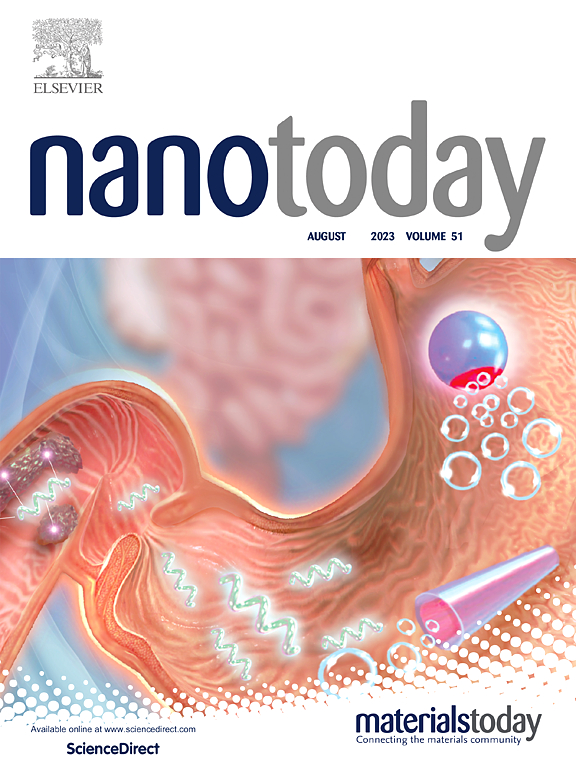磁粒子成像的微型化和低能耗方法
IF 13.2
1区 材料科学
Q1 CHEMISTRY, MULTIDISCIPLINARY
引用次数: 0
摘要
磁颗粒成像(MPI)作为超顺磁性氧化铁纳米颗粒的一种新兴应用,被认为是一种有前景和竞争力的医学成像技术。然而,MPI仍处于起步阶段,大多数提出的设备需要大量的功率并占用显著的物理足迹,因此小型化和节能一直是研究重点之一,也是临床转化的关键驱动力。本文重点介绍了在MPI系统中实现简化、集成、降低成本和提高能效的新技术和设计理念,包括基于先进电磁模块开发的内部优化策略,面向多功能和多模态诊断和治疗设备的集成优化策略。以及整合跨学科方法(如超导和纳米技术)的系统优化策略。其中,内部设计是基础,如细化磁场设计,整合各种功能模块,引进先进的电磁材料等。从减少医疗设备的整体尺寸和能耗的角度来看,MPI可以与其他诊断和治疗技术集成,这不仅可以促进先进的方法,还可以节省开发和运营成本。此外,跨学科的方法提供了更有效的解决方案,高性能的磁示踪剂和信号处理算法有助于降低对大型功能模块和强电磁场的依赖。本文对微型化和低能耗途径进行了系统、专业的探讨,并对MPI的发展现状进行了新的展望。本文章由计算机程序翻译,如有差异,请以英文原文为准。
Miniaturization and low energy consumption approach to magnetic particle imaging
As an emerging application of superparamagnetic iron oxide nanoparticles, magnetic particle imaging (MPI) is considered a promising and competitive medical imaging technology. However, MPI is still in its infancy and most proposed devices require large amounts of power and occupy a significant physical footprint, hence miniaturization and energy reduction have been one of the research emphases and a crucial driving force for clinical translation. This review focuses on the novel technologies and design philosophies that lead to simplification, integration, reduced costs, and improved energy efficiency in MPI systems, including internal optimization strategies based on advanced electromagnetic modules development, integration optimization strategies orienting multifunctional and multimodal diagnostic and therapeutic equipment, and systematic optimization strategies that incorporate interdisciplinary approaches such as superconductivity and nanotechnology. Among those, internal design is the foundation, for instance, refining magnetic field designs, integrating various functional modules, and introducing advanced electromagnetic materials. From the perspective of reducing the overall size and energy consumption of medical equipment, MPI can be integrated with other diagnostic and therapeutic technologies, which not only fosters advanced methods but also saves on development and operational costs. Furthermore, the interdisciplinary approaches provide more effective solutions, that high-performed magnetic tracers and signal processing algorithms contribute to a lowered dependence on large-scale functional modules and strong-electromagnetic fields. This review offers a systematic and specialized discussion on the miniaturization and low energy consumption approaches, as well as a fresh perspective on the development status of MPI.
求助全文
通过发布文献求助,成功后即可免费获取论文全文。
去求助
来源期刊

Nano Today
工程技术-材料科学:综合
CiteScore
21.50
自引率
3.40%
发文量
305
审稿时长
40 days
期刊介绍:
Nano Today is a journal dedicated to publishing influential and innovative work in the field of nanoscience and technology. It covers a wide range of subject areas including biomaterials, materials chemistry, materials science, chemistry, bioengineering, biochemistry, genetics and molecular biology, engineering, and nanotechnology. The journal considers articles that inform readers about the latest research, breakthroughs, and topical issues in these fields. It provides comprehensive coverage through a mixture of peer-reviewed articles, research news, and information on key developments. Nano Today is abstracted and indexed in Science Citation Index, Ei Compendex, Embase, Scopus, and INSPEC.
 求助内容:
求助内容: 应助结果提醒方式:
应助结果提醒方式:


